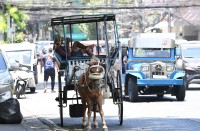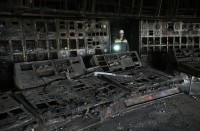A Beijing-based artist sticks his artwork onto abandoned buildings in the Chinese capital to comment on the city’s rapid development.
A 25-year-old artist in Beijing called ROBBBB prefers to display his work on the walls of abandoned buildings, rather than a gallery.
His artwork is mostly derived from photos of people he sees in the Chinese capital — anyone ranging from elderly people to construction workers.
Construction work is a common sight in the cities of China, which has seen three decades of breakneck growth.
ROBBBB said his work comments on the development of Beijing, home to 11.5 million people and the capital of the world’s second largest economy.
“After the ’08 Olympics, Beijing developed more and more rapidly. Tall buildings and towers rose from the ground, producing more urban ruins. I believe that these ruins are the intersection of the city’s development. They’re actually just like street art — they all contain some sort of temporary quality. I hope that years later, people will see my art and think of Beijing of that time,” he said.
He said he’s not concerned about whether the general public understands his artwork.
“Actually, the fact that passersby, or the Chinese public, are unable to understand my art, is not at all important. What’s more important is to reflect my own inner thoughts with this art, as well as my reflections on this society that I live in,” he said.
ROBBBB said he works as a freelancer for various advertising and design projects and the income funds his street art.
To date, ROBBBB said he has put up nearly 200 pieces of his work on the walls of abandoned or partially-destroyed buildings across Beijing.
While graffiti is illegal in some countries, China does not have strict laws against it.
Many residents are not used to the sight of it.
“This sort of form of art is pretty uncommon in China. I’ve read more about these forms of art in the news, or magazines from other countries,” said a 60-year-old resident, Mr. Sun.
Others welcomed ROBBBB’s artwork.
“There is something special about this street art. When I just walked by, I thought that this auntie really looked like a real person, and there is something three-dimensional about the vegetables (in her bag). With this combination it appears pretty life-like, and coming to a traditional Beijing alley for the first time, I think it’s very unique,” university student from Guangdong province, Li Xiabing said.
ROBBBB said his name came from his English name, Rob. The second ‘b’ stands for Beijing, the third for Blek le Rat, a stencil graffiti artist in Paris, and the fourth for “best”, to encourage himself to work hard.







